Editor’s note: The reopening of Los Angeles County has been changing by the day. As we were going to press, the county was relaxing more of the “Safer at Home” measures. Please check covid19.lacounty.gov for the latest information on which types of businesses are reopening.
Mona Khalbourji stands in her empty boutique in Weymouth Corners, mask on her face, surrounded by racks and shelves overly stocked with the latest seasonal fashions and accessories.
“Wait, I have something to show you,” she says to me as she darts into the back room. She quickly returns with a few specialty wine bottles with her store’s logo on the label. They were meant for a milestone party that’s since been postponed.
Mandyz, the clothing store she’s owned since 2010, would’ve celebrated its tenth anniversary in May with a huge party had it not been for a certain coronavirus pandemic that forced the nonessential-deemed business to temporarily close since mid-March.
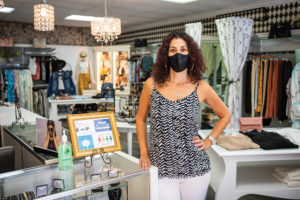
FINALLY OPEN: Mandyz Boutique owner Mona Khalbourji poses wearing the hottest fashion accessory, a face mask. The store celebrated its 10th anniversary in May. (photo: John Mattera Photography)
“My initial reaction was panic and fear,” says Mona. “You are never really prepared for having to close your business down due to uncertain circumstances and not knowing when I can reopen and what’s going to happen.”
The ramifications of the COVID-19 pandemic has been felt twofold in the Khalbourji family. Across the street, her husband Robert’s business, Golden Treasure Jewelers, is facing the same ambiguous future.
“Having owned and operated my jewelry store for the past 20 years, suddenly not being allowed to open was a complete shock,” says Robert. “We were not ready for this… but we will get through it together.”
Mona adds, “Any business that was forced to shut down for two months will definitely be financially impacted. It’s been very tough having no income and still having bills to pay along with a boutique filled with merchandise and no one to sell it to.”
All across San Pedro, as part of L.A. Mayor Eric Garcetti’s “Safer at Home” orders, local mom-and-pop retailers deemed nonessential by L.A. County have been ordered to temporarily close since mid-March. This turned shopping districts like Downtown San Pedro and Weymouth Corners into ghost towns practically overnight, with restaurants (open for takeout and delivery only), grocery stores, and pharmacies showing the only signs of life.
Fortunately, last month the county eased restrictions allowing most retail businesses to reopen if they follow new safety protocols like curbside pickup, social distancing, wearing of masks, and maintaining sanitary guidelines. The county is shooting for a “full reopening” of malls, restaurants, and other retail by July 4, completing Phase 2 of the state’s Resilience Roadmap, with Phase 3, which includes hair salons and gyms, on the horizon.
But what does reopening look like for retail in the age of coronavirus? On May 7, the Los Angeles County Department of Public Health released details on five key areas retail stores must address in order to properly reopen. These areas include “workplace policies and practices to protect employee health, measures to ensure physical distancing, measures to ensure infection control, communication with employees and the public, and measures to ensure equitable access to critical services.”
For a store like Mandyz, this would mean scheduling personal appointments, limiting the number of people inside, requiring masks for customers and employees, providing hand sanitizer, and being able to pick up orders curbside.
“The transition [to follow protocols] isn’t very difficult,” says Mona. “It is certainly an adjustment to get used to, but we have to adapt and do what we need to do to move forward.”
Across the street, Robert is a little more skeptical. His type of business traditionally offers a more personal touch, and these requirements, especially social distancing, will completely change the manner in which he’s done business for the past two decades.
“Jewelry is a very personal business and requires a personal interaction between my customers and myself,” he explains. “Customers like to see merchandise up close, so with all the new rules in place, I will need to adapt to this new normal.”
IT’S QUIET DOWNTOWN
Two miles away, Downtown San Pedro remains eerily silent.
It’s noon on a Thursday in late May and the normally bustling lunch rush on Fifth, Sixth, and Seventh Street has been replaced by cars stopping to pick up to-go orders and quickly speeding away. It’s been two months since anyone has been able to dine inside a restaurant in L.A. County and the San Pedro restaurant community, especially those in downtown, are being hit hard.
“We have had a 75% drop in business. Never thought I’d say that,” says James Brown, owner of San Pedro Brewing Company. “We’ve been able to keep 22 of our 47 employees working part-time. Everyone else has been on unemployment.”
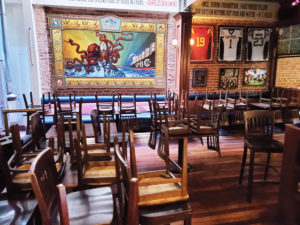
DAY 68: On May 21, Brown posted this photo with the caption: “It’s day 68 of not having [one] person sit in my restaurant. July 4th isn’t going to cut it. Let’s get moving LA County. Indoor at 25-50%, outdoor, whatever!” (photo: courtesy James Brown, San Pedro Brewing Co.)
What’s even more concerning for restaurant owners is, even when they’re allowed to reopen for in-person dining, how will a restaurant like the Brew Co., one of the larger dining establishments in the downtown area, be able to turn a profit with the expected social distancing and safety protocols?
“Frankly, I don’t know how I’m going to make a profit,” explains Brown. “Fifty percent capacity in a business that runs on tiny margins is going to be tough. We are all about volume. Our bar is always busy, and I don’t know how many barstools I can use.”
It’s clear that everything is going to boil down to space. The larger restaurants, like Pappy’s, the Whale & Ale, the Brew Co., and Kalaveras, will have an easier time adjusting to the new social distancing standards than the smaller bistro-sized eateries like Sebastian’s Mediterranean Cuisine and Compagnon Wine Bistro.
“We are fortunate enough to have four dining areas to help with distancing, but this will require more labor,” says Brown.
To compete with the increased labor and supply costs (proposed single-use menus and silverware aren’t cheap) and the decrease in volume, most restaurants will likely have to pass on these costs to customers in the form of higher prices, proving no one is immune from the economic shortfalls of this pandemic.
“We’ll encourage people to use their phones to look at our menu,” says Brown. “I’m going to blow up and post menus to hang on the wall.”
TAKIN’ IT TO THE STREETS
Fortunately, some relief may be coming to Downtown San Pedro in the form of a citywide outdoor dining program being spearheaded by L.A. City Councilman Joe Buscaino. The program seeks to create a temporary “low-cost permit process” allowing the City to use sidewalks, parking lots, and streets for outdoor dining, exercise, and recreation. This will also allow restaurants to maximize volume while maintaining social distancing and safety protocols. Details on when this new program will take effect were not available at press time, but it’s safe to say it’ll be sooner rather than later.
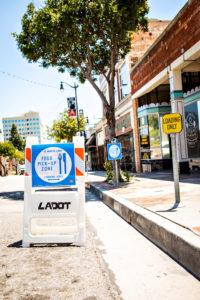
Food pickup signs line Sixth Street in Downtown San Pedro. (photo: John Mattera Photography)
“As the state of California continues to slowly reopen, local governments must find creative ways to support our small businesses to retain jobs and create a new normal,” said Buscaino in a statement. “Creatively repurposing our public spaces to accommodate more uses will protect people’s health, save jobs, and save our local restaurants.”
Downtown property owners like Eric Eisenberg, president and CEO of The Renaissance Group and board member of the San Pedro Property Owners’ Alliance (PBID), have supported establishing some form of outdoor dining in the downtown district for years. In fact, just last fall, the PBID won approval from city officials to install street and sidewalk dining spaces within the downtown district. This current program proposed by the councilman, Eisenberg explains, is different.
“The new temporary outdoor program is different from the permanent one that PBID had already [been approved for]… [that] calls for 13 spaces to be built out both on sidewalks and streets,” he says. “The new program that we are fast-tracking together with the council office is a cut-down version that utilizes parking spaces right in front of businesses and may only have k-rail or cement planters as borders for safety.”
Eisenberg, whose tenants include Sebastians’s and Happy Diner, among others, adds, “Street closures are only added in for use as needed and are not intended to be permanent from the PBID’s perspective.”
According to Jonathan Williams, president of the San Pedro Property Owners’ Alliance, most of the downtown restaurants have remained open for curbside pickup and delivery.
“In total, over 20 of our downtown restaurants were able to continue their operations and support local residents during this time,” he said in a statement. “The community response has been overwhelmingly positive, and we are grateful to see our businesses sustained by the generous support of San Pedro residents. We are excited to see the recent progress in retail openings and look forward to the recovery data in the coming months.”
Like Williams, Eisenberg remains positive that as restaurants and businesses begin to reopen, the San Pedro business community, especially in downtown, will recover.
“As a whole, Downtown San Pedro will emerge from this disaster better, stronger and more economically sustainable,” he says. “We have some exciting projects coming to market now and others to be built in the near future; that’s why I’m all in on our recovery.” spt

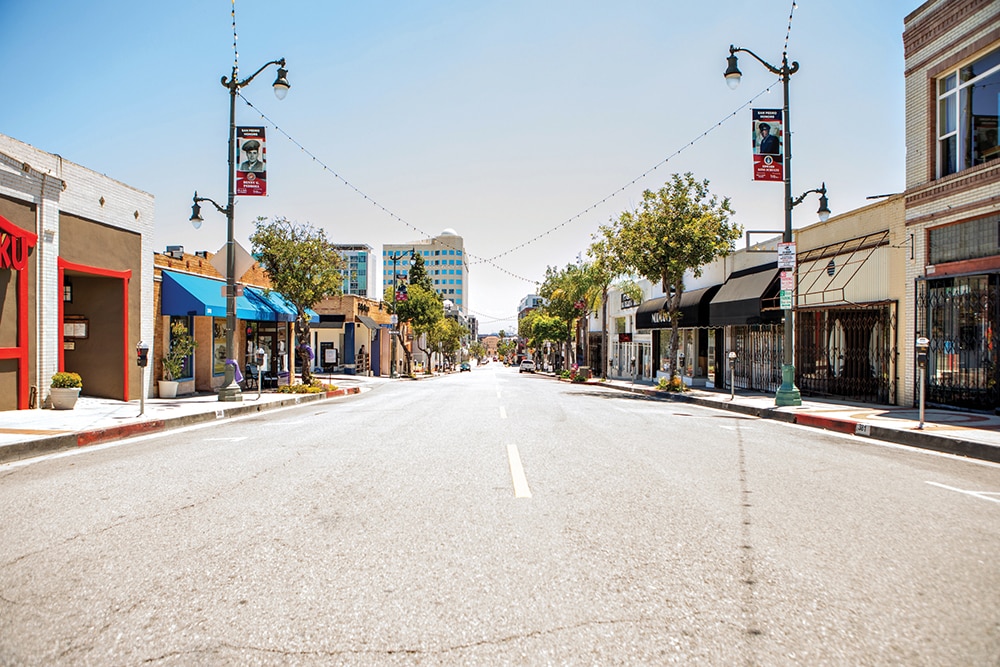

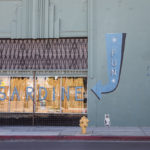

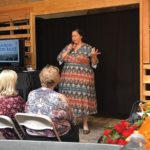
Comments